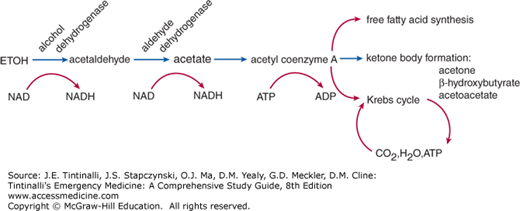INTRODUCTION
Alcoholic ketoacidosis is a wide anion gap metabolic acidosis, most often associated with acute cessation of alcohol consumption after chronic alcohol abuse, and is typically associated with nausea, vomiting, and vague GI complaints.1 Metabolism of alcohol combined with little or no glycogen reserves results in elevated ketoacid levels. Although alcoholic ketoacidosis is usually seen in chronic alcoholics, it has been described in first-time binge drinkers. Repeated episodes can occur.2 Although with proper treatment this illness is self-limited, death has been reported from presumed excessive ketonemia.2,5,4
PATHOPHYSIOLOGY
Ethanol metabolism requires nicotinamide adenine dinucleotide (NAD) and the enzymes alcohol dehydrogenase and aldehyde dehydrogenase to convert ethanol to acetyl coenzyme A. Acetyl coenzyme A may be metabolized directly, resulting in ketoacid production; used as substrate for the Krebs cycle; or used for free fatty acid synthesis (Figure 226-1).
Alcoholic ketoacidosis occurs when NAD is depleted by ethanol metabolism, resulting in inhibition of the aerobic metabolism in the Krebs cycle, depletion of glycogen stores, ketone formation, and lipolysis stimulation. Ethanol metabolism results in NAD depletion manifesting as a higher ratio of the reduced form of nicotinamide adenine dinucleotide (NADH) to NAD. When glycogen stores are depleted in a patient stressed by concurrent illness or volume depletion, insulin secretion is also suppressed. Under these same conditions, glucagon, catecholamine, and growth hormone secretion are all stimulated. This hormonal milieu inhibits aerobic metabolism in favor of anaerobic metabolism and stimulates lipolysis. Acetyl coenzyme A is metabolized to the ketoacids, β-hydroxybutyrate (βHB) and acetoacetate.
NAD is used in the conversion of βHB to acetoacetate (AcAc + NADH βHB + NAD). Due to the depletion of NAD, βHB is the predominant ketone product formed. Normally, the ratio of acetoacetate to βHB is 1:1; however, in alcoholic ketoacidosis, the ratio can be 1:7 or higher.5 Once the NADH:NAD returns to normal, lactate levels decrease and acetoacetate increases.1 The ratio of βHB to acetoacetate is also much higher in alcoholic ketoacidosis than in diabetic ketoacidosis.1 The high NADH:NAD ratio also results in increased lactate production, so lactate levels are higher than normal in alcoholic ketoacidosis but not as high as in shock or sepsis. Acetoacetate is metabolized to acetone so that acetone and its metabolites are elevated and may cause an osmolal gap.
Ketone production can be further stimulated in malnourished, vomiting patients or in those who are hypophosphatemic.6 Both conditions are seen commonly in alcoholic patients with alcoholic ketoacidosis.
CLINICAL FEATURES
The typical history is an episode of heavy drinking followed by vomiting and an acute decrease in alcohol consumption. The most common symptoms are nausea, vomiting, and nonspecific abdominal pain.2 Associated gastritis or pancreatitis may occur. Mental status changes are typically secondary to other causes, such as toxic ingestion, hypoglycemia, alcohol-withdrawal seizures, postictal state, or unrecognized head injury.
DIAGNOSIS
Diagnosis is made in the appropriate clinical setting and is based on laboratory evaluation. Laboratory evaluation should include CBC; electrolyte panel with calcium, phosphate, and magnesium; ethanol, methanol, and isopropyl alcohol levels; hepatic enzymes; lipase; and serum ketones. Determination of serum lactic acid level and serum osmolality also may be helpful. Diagnosis is made by the criteria listed in Table 226-1
Stay updated, free articles. Join our Telegram channel

Full access? Get Clinical Tree








